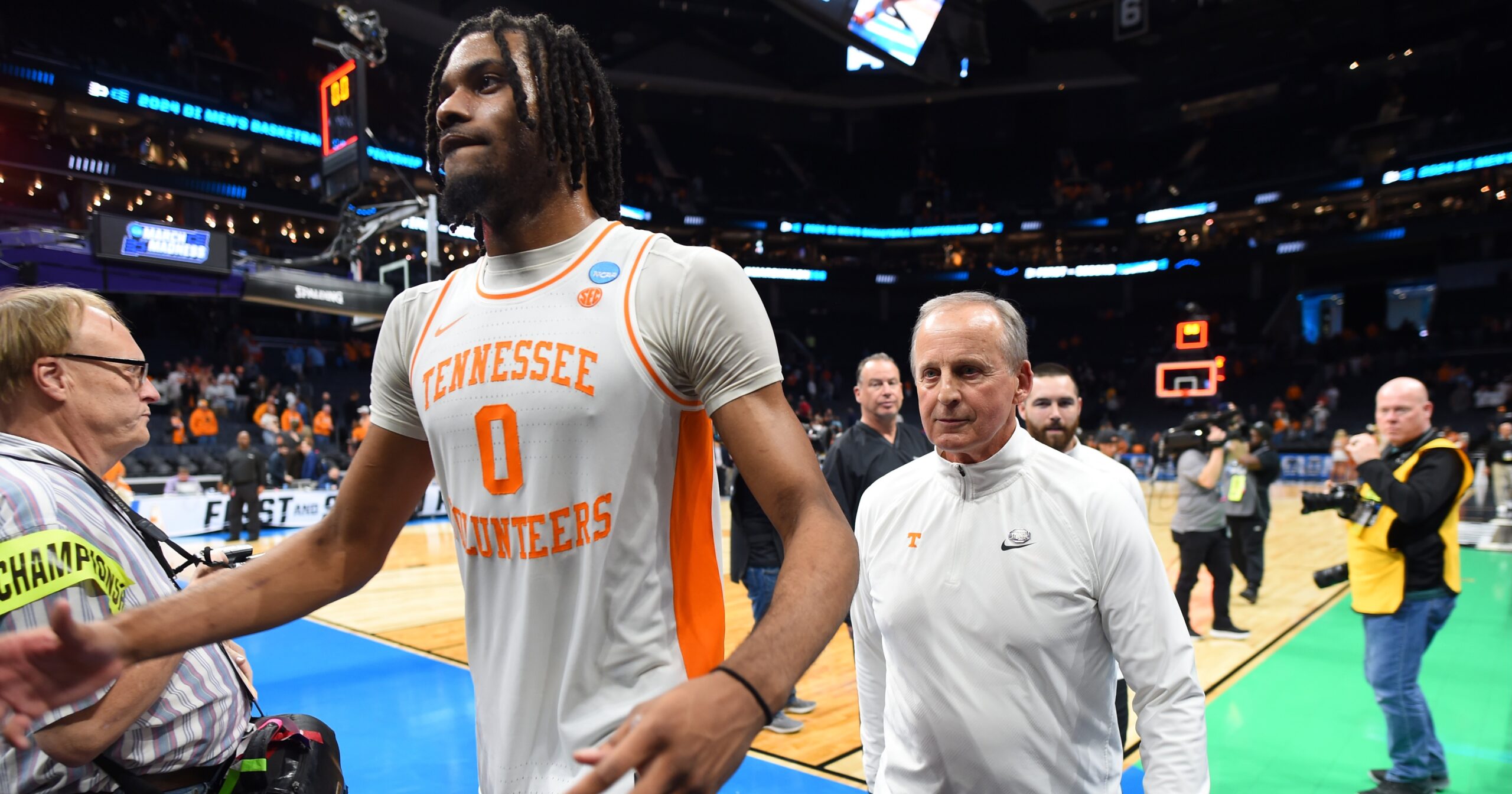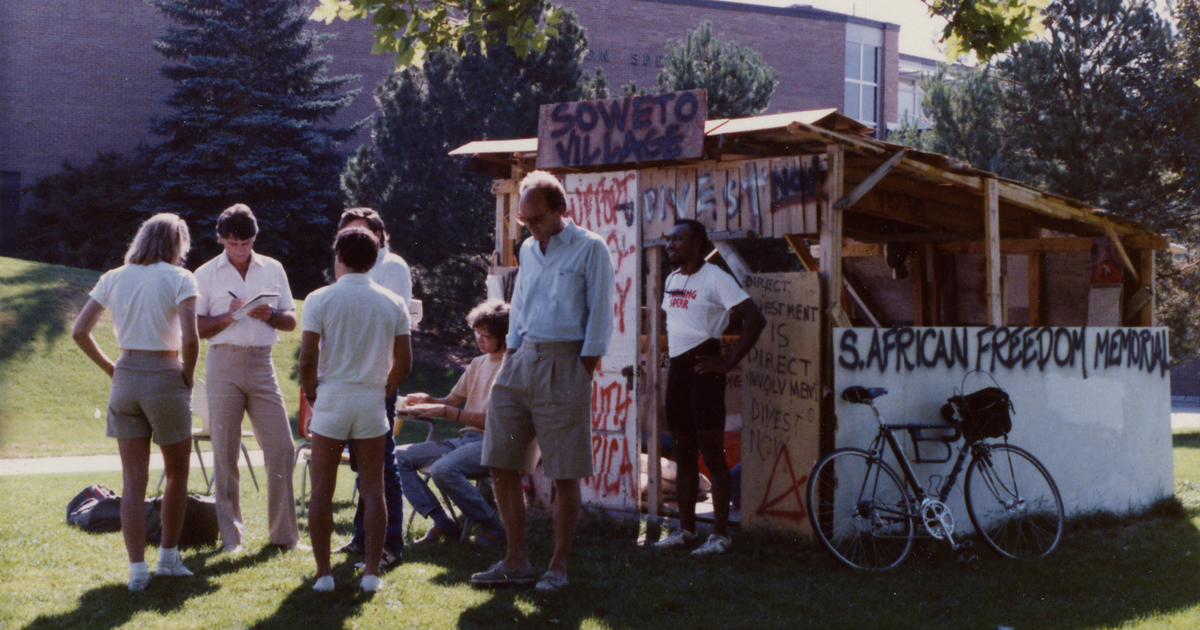Entertainment
The best songs from Taylor Swift's 'Tortured Poets Department' double album

Taylor Swift wrote so much “tortured poetry” over the past two years that she didn’t know what to do with it all.
In true TSwift fashion, the pop star surprised fans with 15 bonus songs two hours after releasing “The Tortured Poets Department” on Friday. The second installment, titled “The Anthology,” was not a true shocker to eagle-eyed Swifties who had observed the singer dropping hints about the number two since she announced the album in February at the Grammys.
With 31 tracks across the two albums, fans have been parsing through the songs and dissecting lyrics since the clock struck midnight. Here are the best songs from the double album.
‘So Long, London’
Even with its stunning melody, the lyrics are the star of this song. Fans are speculating that the track is a sequel of sorts to “London Boy” from 2019’s “Lover,” which details the highs of her relationship with former longtime partner Joe Alwyn. “So Long, London” follows Swift’s tradition of saving the most devastatingly beautiful tune for Track 5, with a level of emotional vulnerability and truth that goes beyond what the singer usually shows. “I’m pissed off you let me give you all that youth for free,” Swift sings with an edge that could kill.
“And I’m just getting color back into my face / I’m just mad as hell ‘cause I loved this place / For so long, London,” she croons as she seamlessly slips back into the chorus.
‘Who’s Afraid of Little Old Me?’
In this searing indictment of the music business, Swift describes how the “circus life” made her “mean.” She mocks the rumors about herself that have surfaced during her time in the spotlight and executes it all with raw, fiery vocals. In the chorus, she jumps the octave to scream the song’s title — it’s haunting and unforgiving. The impactful chorus makes this song more memorable than some of its melodically repetitive peers.
‘But Daddy I Love Him’
Only Swift could pull off a song that simultaneously calls out her fan base and instantly becomes one of their favorites. In this track, which seems to address the criticism Swift faced for her brief relationship with controversial The 1975 frontman Matty Healy, Swift says she would rather “burn [her] whole life down” than “listen to one more second of all this bitching and moaning” about the fling. The verses lean into Swift’s country roots then bloom into a familiar pop-infused chorus.
Swift is probably the only artist who could squeeze the phrase “sanctimoniously performing soliloquies” into an upbeat tune.
‘I Can Do It With a Broken Heart’
This sparkling song is a classic move of Swift’s: an upbeat tune that just makes you want to dance. But that bubbly melody is accompanied by some of her most crushing lyrics (have you listened to the bridge of “Cruel Summer” lately?). Through those crushing lyrics, Swift admits that while she was selling out stadiums and bringing the dazzling Eras tour across the country this summer, she was reeling from her breakup with Alwyn.
“All the pieces of me shattered as the crowd was chanting, ‘More,’” she sings. The incongruity of the lyrics and the peppy melody convey the pain she was experiencing at the height of her career. “You know you’re good when you can even do it with a broken heart,” she sings, cheekily adding, “Try and come for my job,” to close out the track.
‘The Black Dog’
This soft ballad opens the second installment of the album with a startlingly relatable breakup experience: checking her ex-boyfriend’s phone location, which he forgot to un-share. She details her ex, presumably Alwyn, walking into a bar called the Black Dog (in London), leaving her wondering how he doesn’t miss her more. “Old habits die screaming,” she sings, suggesting she’s having a difficult time letting go of the relationship.
‘The Smallest Man Who Ever Lived’
In another song rumored to be about Healy, Swift says she doesn’t want her ex back, she just wants to know if “rusting [her] sparkling summer was the goal.” The scathing song details the end of a relationship that deeply affected Swift; “I would’ve died for your sins / Instead I just died inside,” she sings. The bridge is one of the best on the album, with haunting lyrics and stellar production.
‘So High School’
“So High School” boasts one of the album’s stickiest melodies, recalling a late-’90s or early-2000s nostalgic sound, which is mirrored by the sentimental lyrics. The tune is rumored to be about Swift’s relationship with Travis Kelce, which, per this song, ignites a child-like giddiness in her. Like “The Alchemy,” some of the lyrics are a little too on the nose about footballer Kelce (“You know how to ball, I know Aristotle”), but the wispy vocals and nostalgic Aaron Dessner production set it apart as a top song from the lot.
‘Florida!!!’ (feat. Florence + the Machine)
Fans were eagerly anticipating the collaboration between Swift and Florence Welch of Florence + the Machine, and it didn’t disappoint. The duo sings that the titular state is “one hell of a drug” in the rousing song about not feeling at home anywhere they go. The escapist anthem features plenty of Welch’s rich vocals, to the relief of fans who have criticized the singer for quick features by past collaborators, notably Lana Del Rey in “Snow on the Beach.”
‘Peter’
Referencing the story of Peter Pan, this ballad explores the pain of distance growing between Swift and someone from her past. She says “Peter” was going to grow up and then return for her but he never does. This song marks the second time Swift has alluded to the story of Peter Pan, with the first mention in “Cardigan” from “Folklore”: “Tried to change the ending / Peter losing Wendy.” Despite its repetitive chorus, the melody is stirring and reminiscent of “New Year’s Day,” a fan favorite from “Reputation.”
‘Down Bad’
“Down Bad” is a pure pop hit, with a clear influence from producer and longtime Swift collaborator Jack Antonoff. The moody chorus (“Now I’m down bad, cryin’ at the gym / Everything comes out teenage petulance / F— it if I can’t have him / I might just die, it would make no difference”) is coupled with a catchy, made-for-radio tune. The song feels like something out of a hybrid of “1989” and “Midnights.”

Movie Reviews
Prasanna Vadanam Movie Review – Gulte
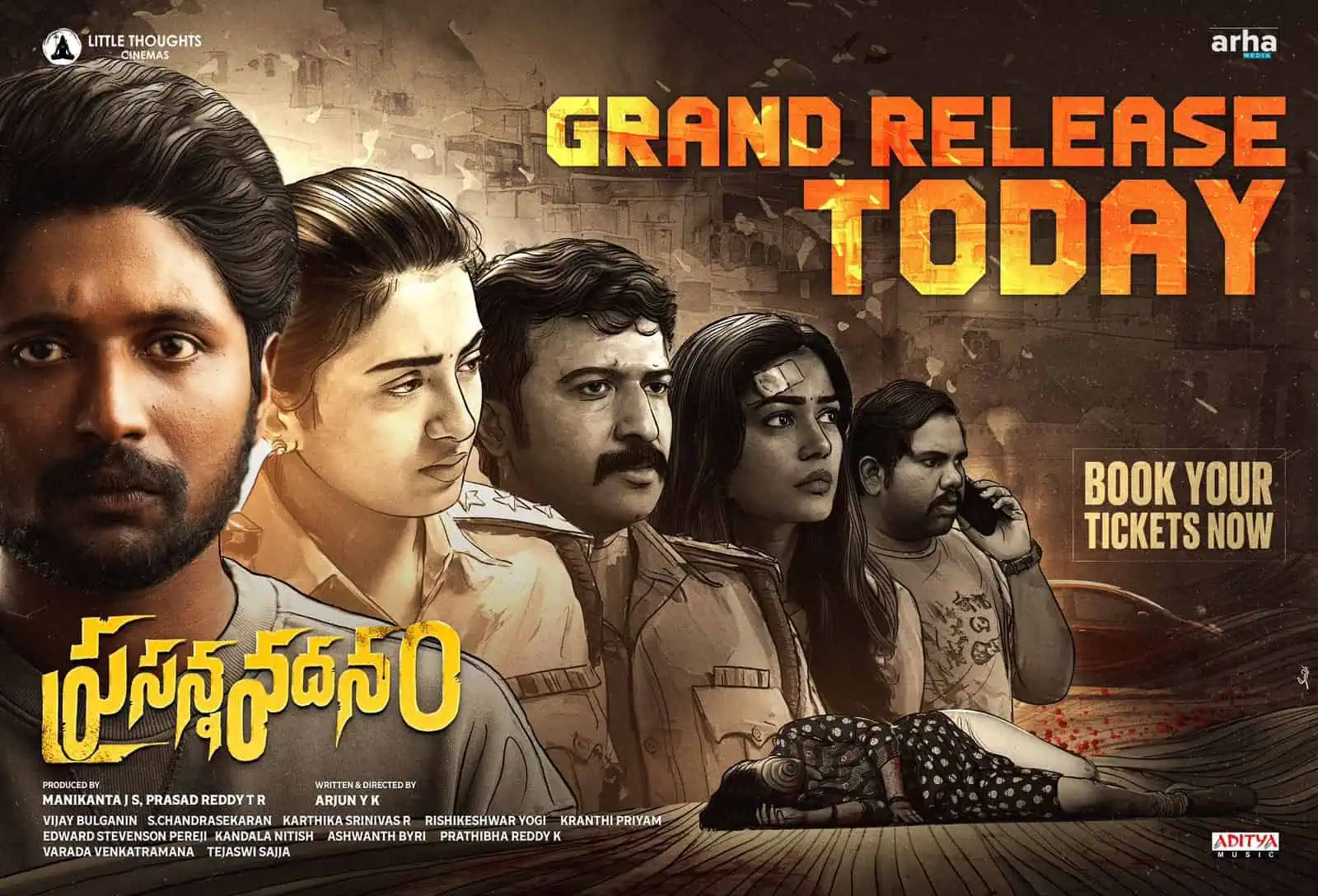
2.75/5
2 Hr 26 Mins | Thriller | 03-05-2024
Cast – Suhas, Payal Radhakrishna, Rashi Singh, Viva Harsha, Nitin Prasanna and others
Director – Arjun Y K
Producer – Manikanta J S, Prasad Reddy T R
Banner – Arha Media, Little Thoughts Cinemas
Music – Vijai Bulganin
Suhas has become one of the bankable actors in Tollywood. He is now out with his latest film, Prasanna Vadanam, based on a man with face blindness. Directed by Arjun YK, let’s review the film here.
Plot
Surya(Suhas), a Radio RJ meets with a terrible accident and ends up with a rare disease named Prosopagnosia. Due to this, he gets face blindness and cannot identify the faces of people around him. One fine day, he witnesses the brutal murder of a young girl. He informs the cops but instead gets embroiled in the case. Left with no choice; he approaches top cop Vaidehi(Rashi Singh) for assistance. But things turn on its head and multiple cases are now filed on Surya. The rest of the story is about how Surya proves his innocence with the help of his girlfriend Adhya(Payal Radhakrishna).
Performances
Suhas is known for his versatile characters gets a tailor-made role in Prasanna Vadanam. As he has a unique disease, the scope for him to perform uniquely is high in the film, and Suhas lives up to all the expectations. His performance in the second half is highly impressive and arrests you till the end. Nithin Prasanna, who was last seen in Ambajipeta Marriage Band, delivers yet another bankable performance. The various shades he showcased in his performance were impressive. Rashi Singh, who played the top cop, was decent, but she should have worked more on the expressions in the latter part of the film. Viva Harsha was okay, and so was Payal Radhakrishna.
Technicalities
Vijay Bulganin composed the music for the film, and his songs are quite ordinary. None of the songs register with the audience, but the background score is quite impressive. The sound design neatly elevates the proceedings and is composed in a stylish manner. The camera work is so-so and one cannot complain keeping the budget in mind. The production values are also okay, and there is nothing much to rave about. The editing is perfect as the narrative is crisp and to the point.
Thumbs Up
Suhas
Interval twist
Thumbs Down
Lag in the second half
Songs
Flashback
Analysis
Making thrillers is one of the biggest tasks for any writer-director. But newcomer Arjun YK has chosen a story with face blindness which is something new for Telugu cinema. So, this itself makes things interesting for Prasanna Vadanam. Prasanna Vadanam starts on a very interesting note, and the best part is that director Arjun does not waste any time entering the conflict point in the film.
Once the heroine is introduced, the love track gets a bit boring, but that too passes, and things become interesting for the audience. Once the crime is committed, the concentration shifts towards the cops and how they will deal with the case. But the way director Arjun brings in the half-time twist is superb and unexpected. As the director reveals the man behind the murder, things become a bit difficult for the director to handle the proceedings.
This is when the proceedings become slow and a bit dull. Also, the reason behind the motive of the murderer is not showcased convincingly. Also, the way Suhas behaves in the second half looks a bit odd. As he has face blindness, the director could have added more drama and played with the effects, but that does not happen, and things move slowly until the pre-climax.
Director Arjun has potential and narrates the film well for the most part. However, way too many cinematic liberties and a lack of hold on emotions are some of the drawbacks. Prasanna Vadanam has decent moments that hold your attention. However, one needs to prepare for the pace and lack of depth in the proceedings as well.
Bottom Line – Passable Thriller
Rating: 2.75/5
Entertainment
'The Phantom Menace' dominated 1999's box office. History has been kinder to it

May 19, 1999, in a galaxy not so far away …
Excitement for “Star Wars” is at an all-time high. The first new film in the beloved series that originally concluded with 1983’s “Return of the Jedi” is about to be released in 2,970 theaters, with a majority starting their first screenings just after midnight. (Ticket sales opened just the week before.)
Audiences have had 16 long years to dream about what George Lucas has conjured up for this new cinematic adventure. But instead of whatever they’d imagined, “Star Wars: Episode I — The Phantom Menace” involves a nefarious trade dispute, myth-altering midi-chlorians and Jar Jar Binks.
And although it becomes, for a while, the second-highest grossing film of all time, the divisive new chapter gains a reputation as one of the worst “Star Wars” movies ever.

The 1999 Project
All year we’ll be marking the 25th anniversary of pop culture milestones that remade the world as we knew it then and created the world we live in now. Welcome to The 1999 Project, from the Los Angeles Times.
Today, “The Phantom Menace” returns to theaters in celebration of its 25th anniversary. In the 19 years since 2005‘s “Star Wars: Episode III — Revenge of the Sith,” the much maligned prequel trilogy has, in many ways, been redeemed.
Just look at how its stars — including Ewan McGregor, Hayden Christensen and Ahmed Best — have been re-embraced by fans in their returns to the franchise in television projects such as “Obi-Wan Kenobi” and “Ahsoka.” Even the actors themselves have voiced appreciation that their original films seem to be regarded more positively. Becoming “more aware of the fondness that the generation that we made the prequels for has for those films … [has] meant a lot to me,” McGregor told NBC News in 2022.
And as the “Star Wars” franchise continues to grow, with upcoming projects including two new series, “The Acolyte” and “Skeleton Crew,” the second seasons of “Andor” and “Ahsoka” and at least two additional films, it has become increasingly apparent just how much of it is built upon a foundation laid down by the prequels. “Star Wars’” most recent successes would not exist if not for “The Phantom Menace.”

“The Phantom Menace” arrived saddled with many expectations. Audiences who grew up on “Star Wars” in theaters or on VHS tapes knew how Darth Vader’s story ended.
“The Phantom Menace” was going to show how it began, something only teased in the original films. Many fans camped outside movie theaters for weeks, just to be among the first to see it. Reports at the time mention that the line outside Westwood’s Village Theatre included about two dozen regulars ages 14 to 40 equipped with couches, recliners, beach chairs, video games and even satellite TV.
“It is only a movie,” The Times reported Lucas insisting during a press event during the lead-up to release. “We have tried hard not to let the film get over-hyped. . . . [It’s] a film for 12-year-olds . . . a Saturday-afternoon serial for children.”
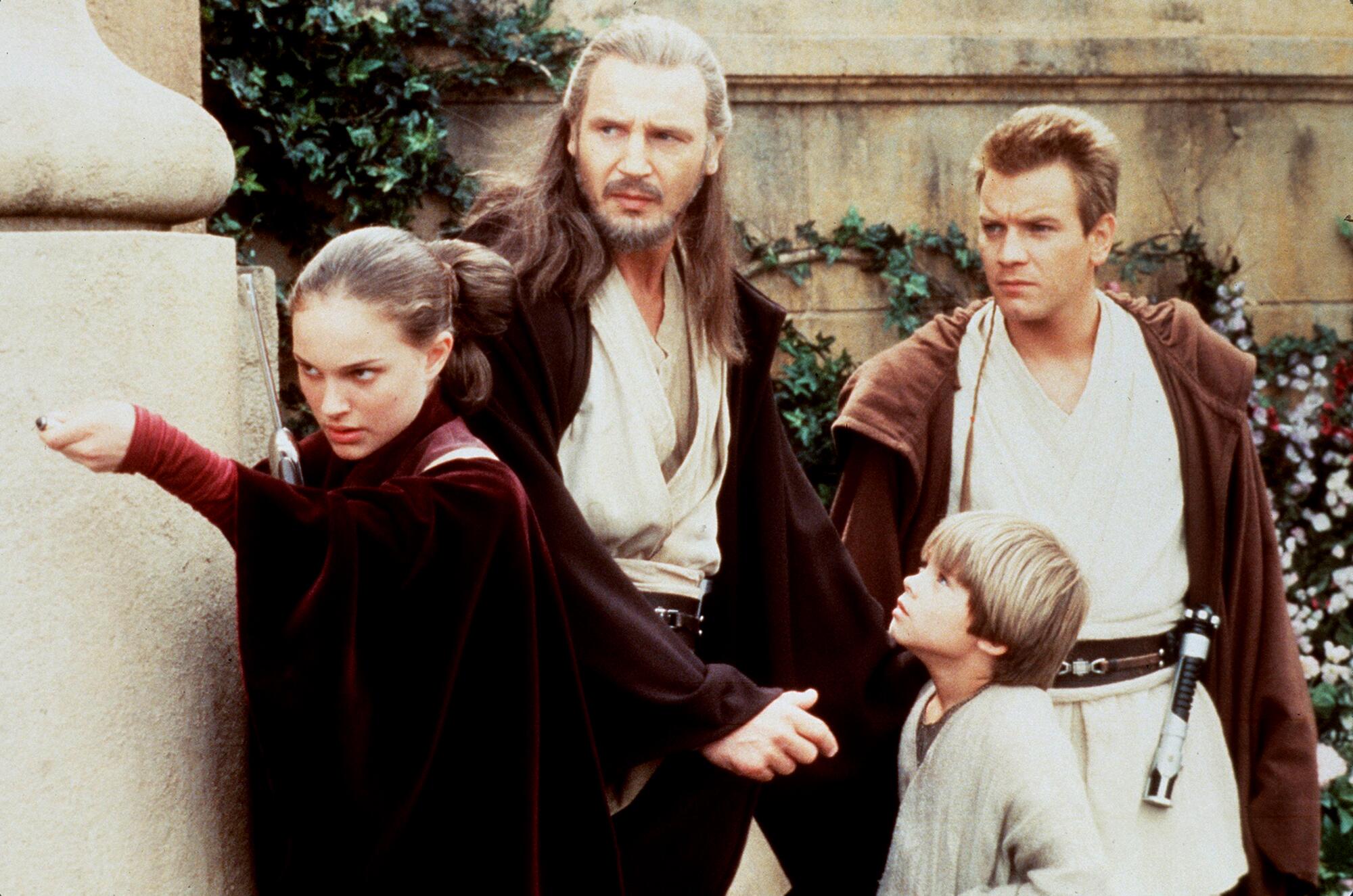
From left, Natalie Portman, Liam Neeson, Jake Lloyd and Ewan McGregor in the movie “Star Wars: Episode I — The Phantom Menace.”
(Keith Hamshere / Lucasfilm Ltd.)
Set roughly 30 years before the events of the original “Star Wars” (which was re-christened “A New Hope” in 1981 after a re-release), “The Phantom Menace” introduced audiences to a 9-year-old Anakin Skywalker (played by Jake Lloyd), a child who would eventually grow up to become Darth Vader.
Anakin’s story begins when a diplomatic mission gone awry brings Jedi Knight Qui-Gon Jinn (Liam Neeson), his apprentice Obi-Wan Kenobi (McGregor), the clumsy and, to some, cringeworthy Jar Jar Binks (Best) and young Queen Amidala (Natalie Portman) to his home planet, Tatooine.
Many critics were underwhelmed. In his review, Times film critic Kenneth Turan described the film as a “considerable letdown” but “certainly adequate.”
It’s “not going to change anyone’s life or method of worship,” wrote Turan. “It’s only a movie, and … a much less impressive one than all the accompanying genuflection would have you believe.” (Lucas, for his part, noted in advance of “Phantom’s” release that the original trilogy got “generally bad reviews” and that he expected the same this time around as well.)
What “The Phantom Menace” did have were state-of-the-art visual effects: Lucas was uninterested in revisiting “Star Wars” until the technology caught up to his vision. The film boasts the first fully computer-generated supporting character in Jar Jar Binks, and regardless of one’s opinion of the character, that is a landmark, paving the way for “The Lord of the Rings’” Gollum and the “Avatar” films.
“The Phantom Menace” also included such memorable sequences as Anakin’s podrace and a lightsaber showdown (referred to by the John Williams theme that accompanies it, the “Duel of the Fates”) between our Jedi heroes and the film’s fantastically designed villain, Darth Maul.

From left, Liam Neeson, Ray Park and Ewan McGregor in the climactic lightsaber duel of “Star Wars: Episode I — The Phantom Menace.”
(Keith Hamshere / Lucasfilm Ltd.)
Still, audiences were much more vocal about the ways “The Phantom Menace” was a disappointment. Criticism of the film included concerns that certain new aliens like the Neimoidians and Gungans appeared to reflect racist tropes. (Lucasfilm rejected those claims as “absurd.”) Any thoughtful responses were drowned out by more vitriolic pushback on everything from the characters and acting to the story and execution.
It was an early glimpse into the darker side of the “Star Wars” fandom — and maybe self-entitled fandom in general. Jar Jar Binks actor Best has been candid about how the negative responses to his character led to his receiving online abuse and death threats. Such bad behavior intensified 16 years later, beginning with the release of the sequel trilogy, which saw stars John Boyega and Kelly Marie Tran becoming targets of racist backlash.
And the newer shows are arriving at a time when “anti-woke” superfans who can’t imagine a “Star Wars” galaxy (one already populated with nonhumanoid aliens) as diverse and inclusive have been increasingly emboldened to make racist and sexist remarks.
Luckily, the “Star Wars” fandom is not defined by that vocal minority.

In recent years, appreciation for “The Phantom Menace” has grown. The 2022 arrival of “Obi-Wan Kenobi,” in particular, had even skeptics reassessing the significance of the prequel trilogy.
“The nostalgia for the prequels can’t redeem those movies in full … But they’re quotable, they’re memeable, and they’re fun to rant against and argue about and rally around,” wrote the Ringer’s Justin Charity.
Part of the reason “The Phantom Menace” has been increasingly embraced is because for a generation of fans, “Episode I” was their first “Star Wars” experience. They‘re now old enough to defend what was to them just as foundational as seeing “Star Wars” in a theater was for kids in 1977.
The prequel films have also been further recontextualized by additional storytelling. Series like the animated “Star Wars: The Clone Wars,” set in the years between the events of “Attack of the Clones” (2002) and “Revenge of the Sith,” have fleshed out the universe. Live-action shows like “The Mandalorian” and “The Book of Boba Fett” have drawn on lore established in the prequel-era stories — with success.
The “Obi-Wan Kenobi” series revisits McGregor’s version of the title character for a glimpse at how the man at the end of “Revenge of the Sith” became the one in “A New Hope” (portrayed by Alec Guinness). Concepts like cloning and even midi-chlorians, the micro-organisms with ties to the Force first mentioned in “The Phantom Menace,” have also endured: The only reason the Mandalorian and Grogu even cross paths is because the remnants of the Empire are so interested in the latter’s midi-chlorian count.

Jake Lloyd and Pernilla August in “Star Wars: Episode I — The Phantom Menace.”
(Lucasfilm Ltd.)
In a larger sense, even shows like “Andor” can trace their DNA to the prequels, by being unafraid to enter into what is considered canon and challenge the assumptions of what is expected of a “Star Wars” story. The franchise has increasingly become one large tapestry where new titles build upon and reframe what came before — not a collection of three classics “owned” by gatekeeping fans. And while subsequent projects do not actually change the quality of past installments, they do sometimes lead to reassessment.
“The Phantom Menace” is also a precursor — for good and ill — of today’s modern media landscape of sprawling IP and interconnected universes like the Marvel Cinematic Universe, DC Universe and even Godzilla’s Monsterverse. Lucas’ enormous box office success not only made an eventual sequel series an inevitability but it also signaled to others that there were possibilities in revisiting dormant worlds to attract new audiences.
The bar for “The Phantom Menace” was set impossibly high — not necessarily by the films of the original trilogy but the audience’s relationship with them. But “Star Wars” movies are special because of their potential to make people fall in love with storytelling just as much as the world itself.
And for a generation that grew up on the prequels, “The Phantom Menace” did just that.
Movie Reviews
Sabari Movie Review: Varalaxmi Proves She Can Do Female Centric Roles
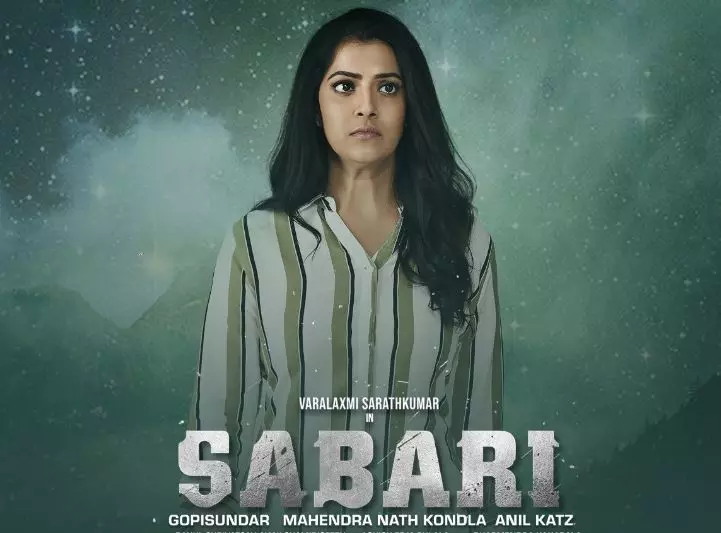
Sabari, starring Varalaxmi Sarathkumar and directed by Anil Katz. The film hit theatres today.
What is it about?
The film follows Sanjana (Varalaxmi Sarathkumar), a single mother whose world is turned upside down when a horrifying truth comes to light: the child she raised is not her biological daughter.
Plot:
The story begins with a twisted past, revealing a villain, Mime Gopi, who escaped a mental asylum with an obsession—finding the daughter he believes was swapped. This sets him on a violent collision course with Sanjana, who will stop at nothing to protect the child she has loved and raised as her own.
Sabari showcases the unwavering bond between a mother and child. As a single parent navigating the challenges of a broken marriage, Sanjana embodies strength and determination.
The movie appears like a psychological horror- thriller at first. While watching the first half, the film comes across a female led emotional thriller where the single parent appears to be going through hardships. Everything goes for a toss in the second half. It is in the second half that the film becomes an irreparable mess. The plot turns are created or arranged in a way that seems unrealistic and artificial.
Verdict: The screenplay of Sabari is far-fetched and the climax is so old that you will not believe this is a film made in 2024. However, Varalaxmi Sarathkumar has delivered a terrific performance.
Rating: 2.75/5
-

 News1 week ago
News1 week agoLarry Webb’s deathbed confession solves 2000 cold case murder of Susan and Natasha Carter, 10, whose remains were found hours after he died
-

 World1 week ago
World1 week agoHaiti Prime Minister Ariel Henry resigns, transitional council takes power
-

 News1 week ago
News1 week agoFirst cargo ship passes through new channel since Baltimore bridge collapse
-

 World1 week ago
World1 week agoUS secretly sent long-range ATACMS weapons to Ukraine
-

 World1 week ago
World1 week agoSpanish PM Pedro Sanchez suspends public duties to 'reflect'
-

 News1 week ago
News1 week agoAmerican Airlines passenger alleges discrimination over use of first-class restroom
-

 Movie Reviews1 week ago
Movie Reviews1 week agoHumane (2024) – Movie Review
-

 Education1 week ago
Education1 week agoVideo: Johnson Condemns Pro-Palestinian Protests at Columbia University
